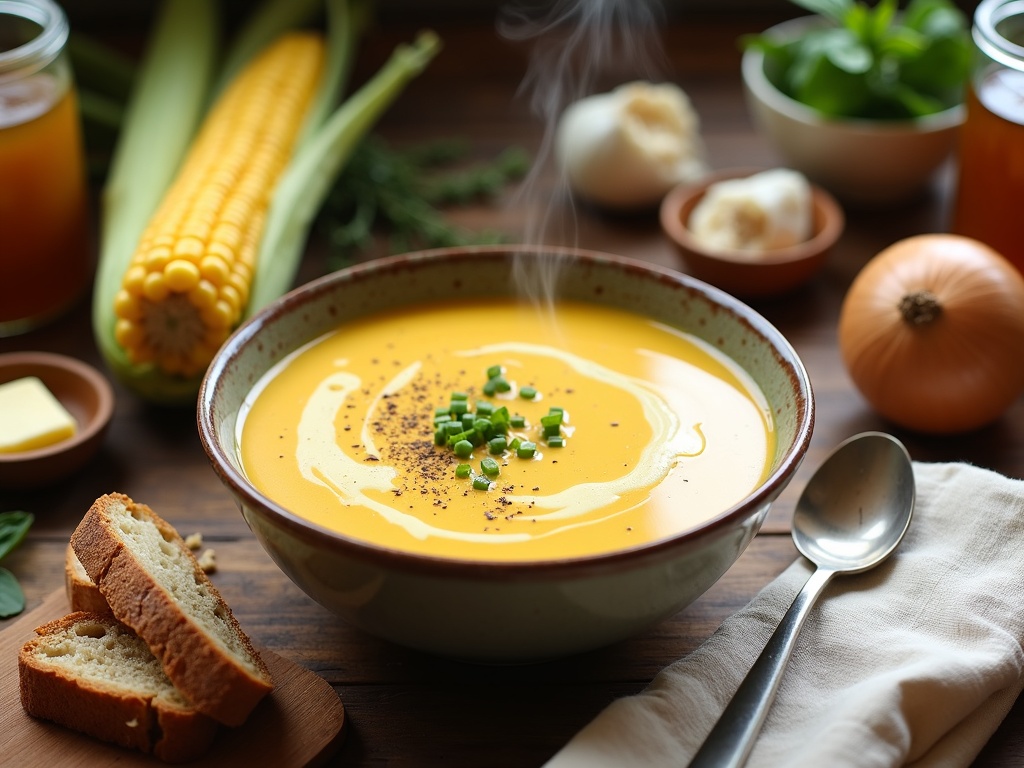I love corn soup for its incredible versatility. It captures the natural sweetness and starch of fresh corn kernels to create a creamy, satisfying texture without much dairy. This comfort food comes together in under 45 minutes and works hot or chilled, making it ideal for any season and easy to customize with different flavor combinations.
Find In This Article
Key Takeaways
- Fresh corn kernels provide the best flavor, though frozen corn works well during off-season months — avoid canned corn which lacks the natural sweetness and texture needed.
- The natural starch from corn creates a luxurious mouthfeel when properly blended, eliminating the need for heavy cream while maintaining a creamy texture.
- For perfect texture, reserve some corn kernels before blending and fold them back in just before serving to create a pleasing textural contrast.
- Corn soup stores well in the refrigerator for up to 3 days and freezes beautifully for up to 3 months, making it perfect for meal prep.
- Beyond its delicious taste, corn soup offers nutritional benefits including fiber, vitamins A and C, and antioxidants while being naturally gluten-free.
What Makes This Soup Special
Corn soup stands out from other soups because it captures the natural sweetness of corn in every spoonful. I’ve found that using fresh corn kernels cut straight from the cob delivers the most vibrant flavor, especially during summer months when corn is at its peak. That said, frozen corn works surprisingly well during off-season months, retaining much of that characteristic sweetness that makes this soup so delightful.
A Creamy Delight Without the Heavy Cream
The velvety texture of corn soup often fools guests into thinking it’s loaded with heavy cream, but that’s the magic of this recipe. The natural starch from the corn kernels creates a luxurious mouthfeel when blended properly. I achieve this by:
- Sautéing the corn slightly longer to release its natural starches
- Blending a portion of the soup to the desired consistency
- Leaving some kernels whole for textural contrast
- Using potato or cashews as natural thickeners instead of dairy
This technique creates a soup that’s incredibly creamy yet lighter than traditional cream-based soups. It’s perfect for those watching their dairy intake or anyone who appreciates a satisfying soup that doesn’t leave you feeling heavy.
The beauty of corn soup is its efficiency – unlike some soups that need hours of simmering to develop flavor, this one comes together in under 45 minutes from start to finish. It’s my go-to option when I need something comforting yet don’t have all day to spend in the kitchen.
While corn soup shines brightest during summer alongside dishes like grilled corn on the cob, it’s equally welcome during colder months when you need a reminder of sunshine. The versatility extends to serving temperature too – serve it hot with crusty bread in winter or chilled like gazpacho soup during summer.
Corn soup also provides a fantastic base for customization. I often vary the flavor profile by:
- Adding roasted peppers for smokiness
- Pairing it with other seasonal vegetables like the ones used in carrot soup recipes for added depth
- Spicing it up with jalapeños
- Infusing it with fresh herbs like basil or thyme
The natural sweetness of corn complements so many flavor directions, making it a soup that’s never boring no matter the season.
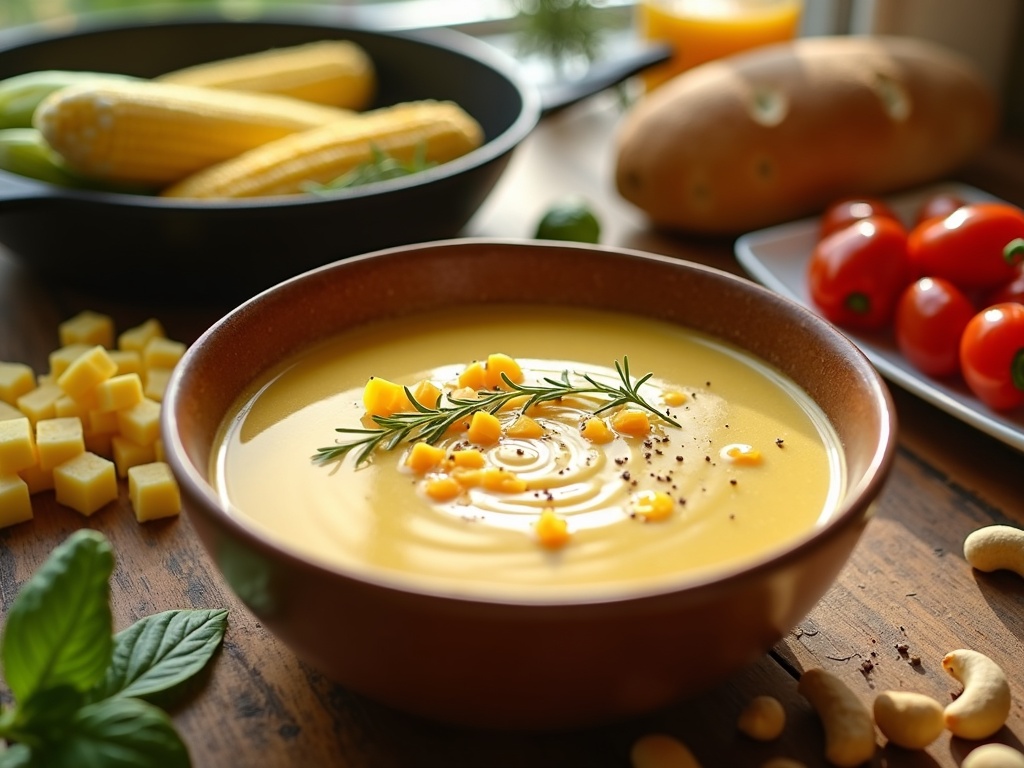
Ingredients You’ll Need
Fresh corn creates the foundation of any delicious corn soup, providing that naturally sweet flavor that makes this dish so comforting. I’ve perfected this recipe through numerous attempts, and these ingredients combine to create the perfect balance of flavors and textures.
Essential Components for Perfect Corn Soup
You’ll need these key ingredients to create a hearty and flavorful corn soup:
- 6 cups fresh or frozen corn kernels (fresh provides the best flavor, especially during summer months)
- 1 medium onion, diced (yellow or white onions work equally well)
- 3 garlic cloves, minced (adds depth without overpowering the corn)
- 4 cups vegetable or chicken broth (vegetable broth keeps it vegetarian-friendly)
- 2 tablespoons butter (unsalted allows better seasoning control)
- 1 cup whole milk (creates creaminess without excessive heaviness)
- Salt and pepper to taste (kosher salt works particularly well)
- Fresh chives for garnish (adds color and a mild onion flavor)
The star ingredient is obviously corn, and I can’t stress enough how much better fresh corn tastes in this recipe. When corn is in season, I buy extra and freeze it for later use. If you’re using fresh corn, you’ll need about 8–10 ears to get 6 cups of kernels. Simply stand the corn upright in a large bowl and carefully cut downward with a sharp knife to remove the kernels.
For those times when fresh corn isn’t available, frozen corn makes a fantastic substitute. The key is to avoid canned corn, which often lacks the sweetness and texture needed for a quality soup.
The combination of butter and milk creates the perfect level of richness without turning the soup into a heavy cream-based dish. This allows the corn flavor to remain front and center. For a dairy-free version, you can substitute with olive oil and your favorite plant-based milk.
Onion and garlic form the aromatic base that enhances the corn’s sweetness. Don’t rush the cooking of these ingredients – they need time to soften and release their flavors properly.
I find that vegetable broth works wonderfully in this soup, keeping it lighter and more corn-focused. However, chicken broth adds a savory depth that complements the sweetness of the corn beautifully. Either option works well depending on your preference or dietary needs.
If you’d like to explore other soup recipes after mastering this corn soup, I recommend trying a refreshing cold vegetable gazpacho in summer or a hearty homemade carrot soup for fall.
For a smoky variation, replace two cups of the fresh corn with grilled corn on the cob kernels. This adds complexity to the flavor profile while maintaining the soup’s essential character.
Fresh herbs make all the difference when finishing this soup. While chives are my go-to garnish, fresh thyme, basil, or even a small amount of rosemary can add interesting flavor dimensions. Just remember that the corn should always remain the star of the show.
With these simple ingredients, you’ll create a corn soup that balances sweetness, creaminess, and savory notes in each spoonful. The beauty of this recipe lies in its simplicity – letting the natural flavors of fresh ingredients shine through without unnecessary complications.
How to Make Perfect Corn Soup
Corn soup is one of those versatile dishes that works as both a comforting winter meal and a refreshing summer treat. I’ve perfected this recipe through countless attempts, finding the perfect balance of sweet corn flavor and creamy texture. The process is straightforward but requires attention to key details that elevate a simple soup into something memorable.
Building the Flavor Base
The foundation of any great corn soup starts with creating a rich flavor base. I always begin by melting butter in a heavy-bottomed pot over medium heat until it’s just beginning to bubble. This is where the magic begins. Two tablespoons of butter provide enough fat to sauté a medium diced onion until it becomes translucent and starts to caramelize slightly around the edges—usually about 5-7 minutes. During the last minute, I add 2-3 minced garlic cloves, stirring constantly to prevent burning.
This aromatic base is critical—the sweetness of properly sautéed onions complements the natural sweetness of corn perfectly. I find that rushing this step results in a less developed flavor profile, so patience pays off here. The butter also adds richness that oil simply can’t match.
Once my aromatics are ready, I add 4-5 cups of fresh corn kernels (about 6-7 ears of corn). If fresh corn isn’t available, frozen works remarkably well too. After stirring the corn to coat it in the buttery mixture, I pour in about 4 cups of vegetable or chicken broth. This liquid should just barely cover the corn.
Bringing the mixture to a gentle boil before reducing to a simmer is crucial. I let it cook for 20 minutes, uncovered, allowing the corn to soften and release its natural starches into the broth. For a deeper flavor, I sometimes toss the empty corn cobs into the broth as it simmers, removing them before blending.
Creating the Perfect Texture
The texture of corn soup can range from chunky to silky smooth—I prefer something in between. After the corn has simmered, I remove the pot from heat and let it cool slightly before blending. For blending, you have several options:
- Immersion blender: Convenient but may leave more texture
- Standard blender: Creates the smoothest result but requires caution with hot liquids
- Food processor: Falls somewhere in the middle
Regardless of method, I never blend it completely smooth. A few tender corn pieces add interesting texture and visual appeal to the final dish. After blending, I return the soup to low heat and stir in about a cup of whole milk or half-and-half. For a dairy-free version, coconut milk creates a silky alternative with a subtle tropical note.
Season carefully at this stage—salt, freshly ground black pepper, and a pinch of cayenne pepper create balanced flavor. Taste as you go, as corn’s natural sweetness varies.
The finishing touches make all the difference in corn soup. I love garnishing with a swirl of cream, fresh herbs (chives or cilantro work beautifully), or a handful of grilled corn kernels for textural contrast. For a refreshing summer variation, I sometimes chill the soup and add diced cucumber, similar to a traditional gazpacho preparation.
This soup should be served immediately while hot, though it keeps well in the refrigerator for up to three days. The flavors often deepen overnight, making it perfect for meal prep. For special occasions, I’ve been known to serve it in small cups as an elegant appetizer, garnished with a single herb leaf or a few drops of chili oil.
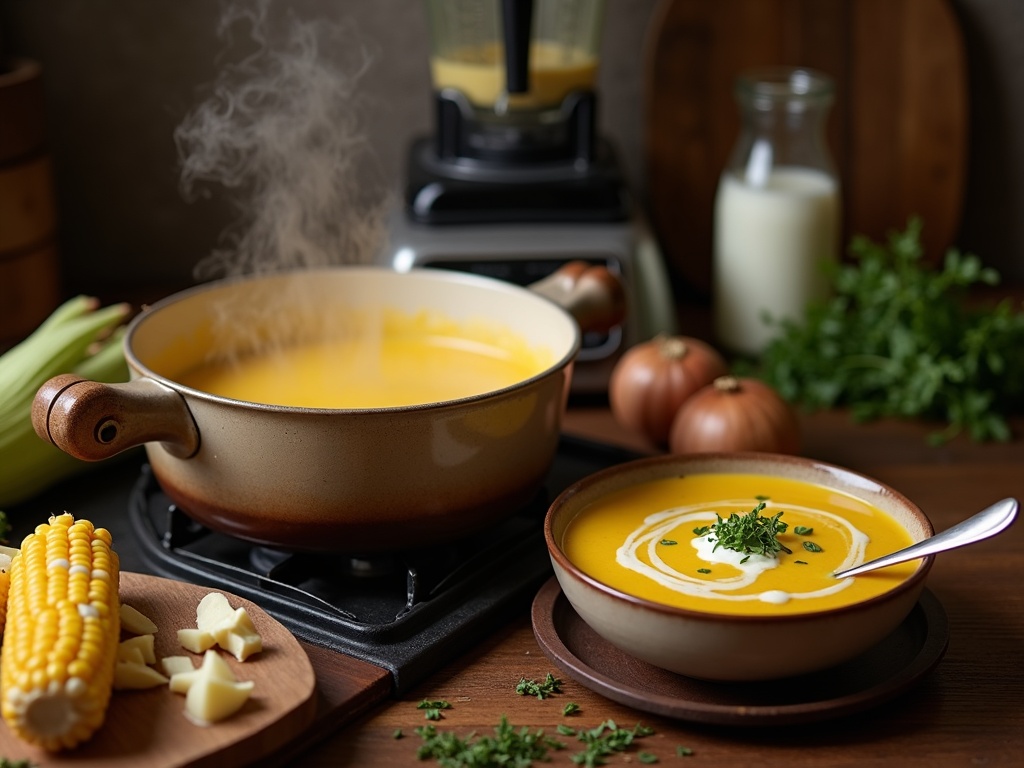
Common Mistakes to Avoid
Making corn soup at home can be surprisingly simple, but there are several common pitfalls that might prevent your soup from reaching its full potential. I’ve seen these mistakes repeatedly in my kitchen experiments and want to help you avoid them.
Key Errors That Affect Flavor and Texture
Using canned corn instead of fresh or frozen is perhaps the biggest mistake you can make. Canned corn often contains added salt and preservatives that alter the natural sweetness of corn. Fresh corn on the cob delivers unmatched flavor – those kernels burst with a sweetness and texture that canned varieties simply can’t replicate. If fresh isn’t available, frozen corn makes a good alternative since it’s typically flash-frozen at peak ripeness. For a truly spectacular corn soup, consider starting with grilled corn on the cob to add a smoky dimension.
Over-blending the soup destroys its character. While some recipes call for a completely smooth texture, over-processing breaks down too much of the corn’s fiber, resulting in a gummy consistency rather than a silky one. I prefer pulsing just enough to break down some kernels while leaving others intact for textural contrast – similar to the approach used in traditional gazpacho soup.
Adding milk too early in the cooking process is a critical error. Milk tends to curdle when boiled, especially in the presence of acidic ingredients like tomatoes that might be part of your recipe. Instead, simmer your soup base first, remove from heat, then stir in cream or milk at the end.
Forgetting to season properly leaves corn soup tasting flat. Corn has natural sweetness, but it needs salt to enhance its flavor. Don’t be afraid to taste throughout cooking and adjust accordingly. Fresh herbs like thyme, chives, or cilantro added at the finish brighten the soup considerably. Taking cues from other vegetable soups like carrot soup recipes can help you understand balanced seasoning.
These simple adjustments—choosing quality corn, controlling texture, adding dairy at the right time, and seasoning thoughtfully—will elevate your corn soup from basic to remarkable without requiring any special techniques or equipment.
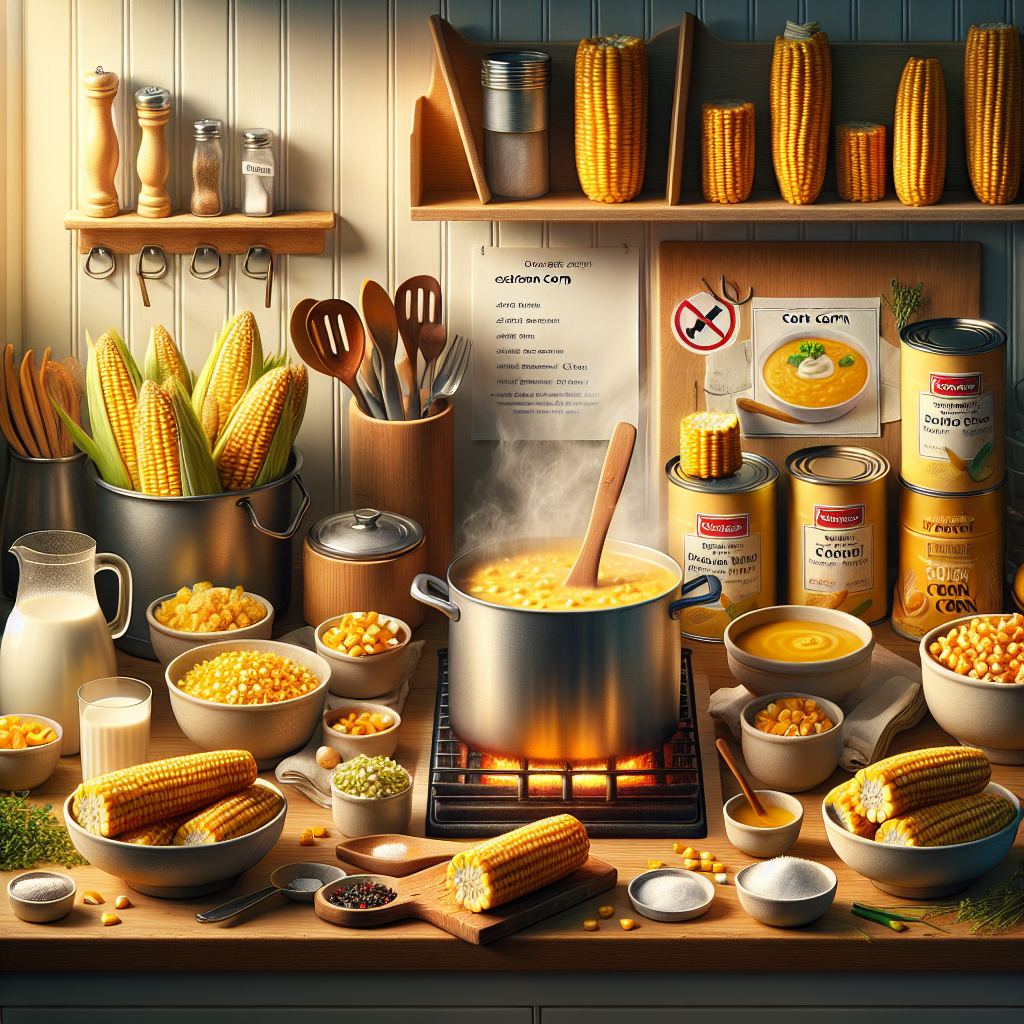
Pro Tips for the Best Results
Making corn soup is fairly straightforward, but with a few expert techniques, I can transform it from good to absolutely memorable. These strategies have helped me consistently create corn soup that impresses even the most discerning guests at my table.
Perfect Texture and Consistency
An immersion blender is my secret weapon when making corn soup. Instead of transferring hot liquid to a countertop blender in batches (which creates more dishes and risks splashing), I simply insert the immersion blender right into my pot. This allows me to control the texture precisely while keeping cleanup simple. For those times when I want ultra-smooth results, I find that blending for 2-3 minutes creates the silkiest texture.
Before blending, I always reserve about a cup of corn kernels. After the main soup is blended, I fold these kernels back in just before serving. This creates delightful textural contrast — smooth, velvety soup punctuated by sweet, tender corn kernels that pop with fresh flavor in each spoonful. This technique works particularly well when paired with dishes like grilled corn on the cob for a full corn-themed meal.
For the ultimate silky consistency, straining the soup after blending makes a remarkable difference. I pour the blended soup through a fine-mesh sieve, using a spoon to gently press the liquid through. This extra step removes any fibrous bits that might have survived blending, creating restaurant-quality smoothness that feels luxurious on the palate.
Time-Saving Preparation
One of my favorite aspects of corn soup is its make-ahead versatility. The flavors actually improve after a day in the refrigerator, which makes this dish perfect for:
- Meal prepping on weekends for quick weeknight dinners
- Preparing a day ahead for special occasions to reduce day-of cooking stress
- Making large batches to freeze in portion-sized containers for up to 3 months
When reheating, I do it gently over medium-low heat, stirring occasionally to prevent scorching on the bottom. If the soup has thickened in storage, I thin it with a splash of stock or cream until it reaches my desired consistency.
For those times when I want to switch up my soup game, I apply similar techniques to other vegetable soups like gazpacho soup or carrot soup with equally impressive results.
Corn soup also serves as an excellent base for customization. After mastering the basic recipe, I’ve found that adding fresh herbs just before serving brightens the flavor enormously. Chives, thyme, or basil make excellent choices. For added richness, a swirl of cream or a dollop of crème fraîche creates an elegant presentation and adds luxurious mouthfeel.
Lastly, I’ve discovered that the freshness of corn dramatically affects the final flavor. During peak corn season, I buy extra corn and freeze the kernels to make this soup year-round. Simply cut the kernels off the cob, spread them flat on a baking sheet to freeze individually, then transfer to storage containers. This preserves that fresh summer flavor even in the depths of winter.
Storage and Serving Suggestions
Fresh corn soup makes a fantastic meal prep option because it stores beautifully and can be dressed up in numerous ways when you’re ready to serve. I’ve found that proper storage extends the life of this delicious soup while preserving its sweet corn flavor.
Storage Options for Maximum Freshness
Once your corn soup has cooled completely, transfer it to airtight containers for refrigeration. The soup stays fresh in the refrigerator for up to 3 days without losing its delightful texture or flavor. For busy weeks, I like to portion it into individual servings for quick lunches or dinners.
For longer storage, corn soup freezes exceptionally well. Pour the cooled soup into freezer-safe containers, leaving about an inch of headspace to allow for expansion. I sometimes use freezer bags laid flat for space-efficient storage. Your corn soup will maintain its quality in the freezer for up to 3 months. When you’re ready to enjoy it, thaw overnight in the refrigerator and reheat gently on the stovetop, stirring occasionally to ensure even warming.
When reheating, you might notice the soup has thickened slightly. Feel free to add a splash of stock or water to reach your desired consistency. A quick stir brings everything back together beautifully.
Serving Suggestions
The versatility of corn soup truly shines in how you choose to serve it. For a complete meal, pair your soup with a slice of crusty bread for dipping – the contrast between the creamy soup and crunchy bread creates a satisfying texture combination. Sourdough or a rustic country loaf works particularly well here.
For toppings that add both visual appeal and flavor dimension, consider these options:
- Crispy bacon bits for a savory, smoky contrast to the sweet corn
- Fresh corn kernels (raw or lightly charred) for texture and to emphasize the corn flavor
- A drizzle of cream or a dollop of crème fraîche
- Chopped fresh herbs like chives, cilantro, or basil
- A sprinkle of smoked paprika or chili flakes for heat
- Crumbled cotija or feta cheese for a salty component
For a summer dinner party, I love serving corn soup as a starter in small cups alongside grilled corn on the cob. This creates a clever theme that highlights the versatility of seasonal corn. In cooler months, corn soup makes a heartier meal when served in larger portions alongside a simple green salad.
If you’re a fan of chilled soups, corn soup can be served cold similar to a gazpacho soup, making it refreshing for summer days. In winter, I sometimes add a pinch of curry powder when reheating for a warming twist that pairs beautifully with the natural sweetness of corn.
For a color and flavor contrast, consider serving your corn soup alongside carrot soup in the same bowl – the orange and yellow create a striking presentation that’s sure to impress guests while complementing each other’s sweet vegetable notes.
These storage and serving suggestions help transform your corn soup from a simple dish into countless meal possibilities throughout the week. With minimal effort, you can enjoy different variations of this versatile soup every time you serve it.
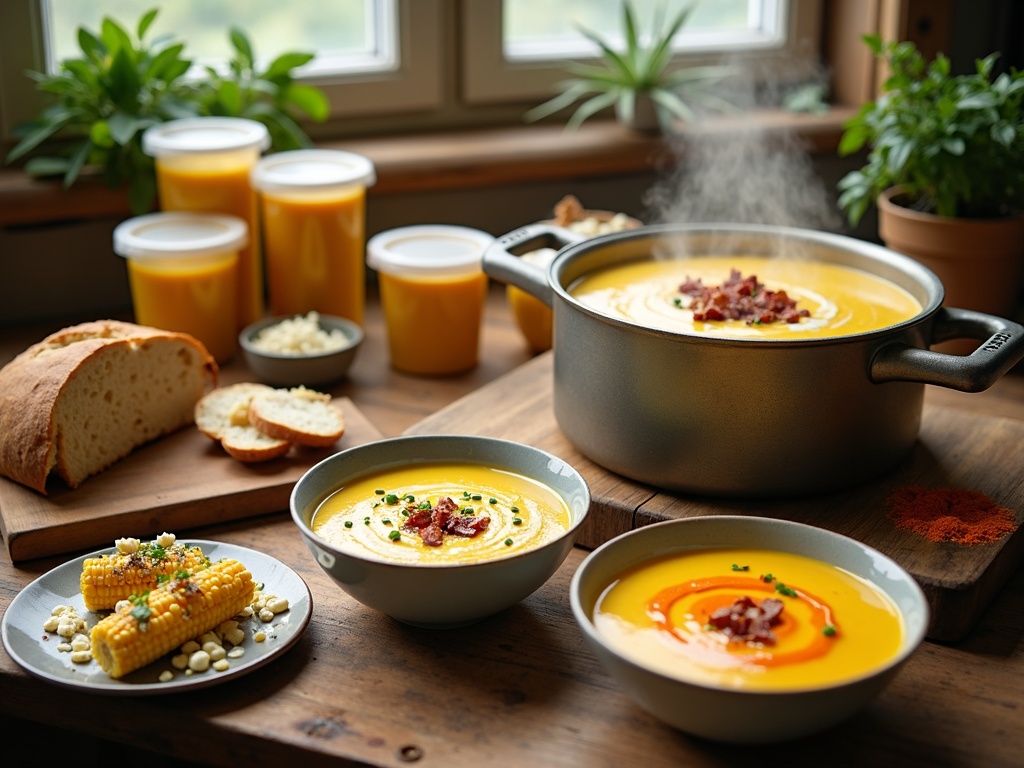
Variations to Try
Corn soup is incredibly versatile, allowing for countless delicious adaptations to suit different palates and dietary needs. I’ve experimented with numerous variations over the years and discovered several standout modifications that can transform a basic corn soup into something extraordinary. These simple tweaks can help you customize your corn soup whether you’re looking for more texture, different flavor profiles, or alternative dietary options.
Exciting Flavor and Texture Enhancements
Adding diced potatoes creates a heartier, more substantial soup perfect for colder months. The starch from the potatoes naturally thickens the soup while adding a comforting texture that complements the sweet corn kernels beautifully. I recommend using waxy potatoes like Yukon Gold or red potatoes as they hold their shape better during cooking, providing distinct bites of potato throughout the soup rather than dissolving completely.
Bell peppers introduce both vibrant color and a sweet, slightly tangy flavor to corn soup. Red peppers offer the sweetest profile, while green peppers contribute a more vegetal taste. For the best flavor development, try sautéing the diced peppers with onions before adding the corn – this caramelizes their natural sugars and intensifies their flavor. This colorful addition pairs especially well with southwestern-style corn soups that feature black beans or roasted grilled corn on the cob kernels.
For those who enjoy some heat, cayenne pepper transforms corn soup from mild to wild. Start with just a pinch and adjust according to your heat tolerance. Alternatively, other spicy options include:
- Fresh jalapeños (diced and sautéed with the aromatics)
- Chipotle powder for smoky heat
- Red pepper flakes for a more subtle warmth
- Hot sauce added at the table for personalized spice levels
Making corn soup vegan is straightforward with coconut milk, which adds richness and a subtle tropical note that pairs surprisingly well with corn’s natural sweetness. Full-fat coconut milk creates the creamiest texture, but light coconut milk works well for a less caloric option. The coconut flavor is particularly complementary in carrot soup recipes that already include corn as an ingredient, creating a sweet, velvety blend.
For a Mediterranean twist, I’ve found that adding fresh herbs like basil or oregano along with a swirl of olive oil creates a lighter soup perfect for summer, similar to the refreshing quality of gazpacho soup but served warm. This variation pairs beautifully with crusty bread and a simple salad for a complete meal.
Texture enthusiasts might appreciate adding a handful of crispy bacon bits as a garnish, creating a delightful contrast to the smooth soup. For vegetarians, crispy fried shallots or toasted pepitas can provide a similar textural contrast without the meat.
Cheese lovers can enhance their corn soup with sharp cheddar or cotija cheese sprinkled on top just before serving. The salty, savory cheese balances the corn’s natural sweetness impeccably.
Each of these variations maintains the essential character of corn soup while introducing new dimensions of flavor, texture, or dietary adaptability. I find that keeping the basic soup recipe simple allows these additions to shine through more effectively, creating distinctive variations that can be enjoyed throughout the year, regardless of season or occasion.
Nutritional Benefits
Corn soup packs a nutritious punch that makes it more than just a comforting meal. This golden bowl of goodness delivers multiple health benefits while satisfying your taste buds. I’ve found that understanding these nutritional advantages can help you appreciate each spoonful even more.
A Nutritional Powerhouse
Corn soup is surprisingly high in fiber, which plays a crucial role in digestive health. A typical serving contains about 2–3 grams of fiber, helping to keep your digestive system running smoothly and potentially lowering cholesterol levels. The fiber content also helps you feel fuller longer, making corn soup an excellent option for weight management.
This sunny soup serves as a good source of vitamins A and C, both essential for immune function and overall health. Vitamin A supports healthy vision and cell growth, while vitamin C helps your body repair tissues and absorb iron. The bright yellow color of corn comes from carotenoids like lutein and zeaxanthin, which are particularly beneficial for eye health.
The antioxidant content in corn soup shouldn’t be overlooked. These powerful compounds help fight inflammation and oxidative stress in the body. Fresh corn contains phenolic compounds that may help reduce the risk of chronic diseases. When making homemade vegetable soups with corn, you’re getting these natural health defenders in each bite.
For those with dietary restrictions, corn soup comes with a natural advantage – it’s inherently gluten-free. This makes it an ideal choice for people with celiac disease or gluten sensitivity. Just be careful about additional ingredients if you’re extremely sensitive to gluten cross-contamination.
The nutritional profile of your corn soup can vary depending on how you prepare it. Adding vegetables like peppers or tomatoes, similar to ingredients found in refreshing gazpacho soup, can boost the vitamin content even further. For a more substantial meal, consider incorporating protein sources like chicken or beans.
Corn’s natural sweetness means you can create a flavorful soup without excessive salt or fat. This makes it heart-healthy when prepared thoughtfully. The natural sugars in corn provide quick energy, while the fiber helps regulate blood sugar response – a balanced combination for sustained energy.
Your corn soup can be customized to highlight different nutritional aspects. For a summer version, using fresh grilled corn on the cob adds a smoky depth while preserving the corn’s natural nutrients. In winter months, frozen corn works wonderfully and retains much of its nutritional value.
I’ve noticed that making corn soup from scratch allows you to control sodium levels, unlike many canned options. This control gives you the freedom to create a healthier version that doesn’t compromise on taste. The simple combination of corn, broth, and a few complementary vegetables creates a nutritional profile that supports overall wellness while delivering comfort in every spoonful.

